A while back now, I wrote a Hifi Pig review of Amptastic’s first product, the diminutive Mini-T class D  amp. That was something of a rave review; genuine audiophile sound quality for a few tens of £.
amp. That was something of a rave review; genuine audiophile sound quality for a few tens of £.
Amazing, astonishing.
I loved that little amp. And I still do. In fact, I still use it as the amplification for a second system, powering a pair of very nice Usher X-719 standmount speakers. A £60 amp powering a £1400 pair of speakers. Loopy stuff! But it works for me.
I keep a Mini-T as a ‘spare’ for my main system as well, just in case a stand-in is required to use with my 5 £figure MBL speakers. Even loopier – but that works for me, too.
Crazed equipment swapper that I am, the Mini-T is one of the very few (quite probably the only) piece of audio electronics that I can return to time after time and still just kick back and enjoy it without any niggly qualms.
But Chris at Amptastic is not one to let the grass grow under his feet, and after extensive design and development work a range of new product, including a DAC, is being rolled out over the coming months. The first of these to be released for sale is the £99 Mini-1 amp reviewed here.
Technicalities
As with the Mini-T, the Mini-1 is based on the superbly transparent TA-2020 chipset. The circuit has been redesigned and refined and better quality components are utilised. The power supply, too, has been uprated and a 5A wallwart PSU comes as standard.
The TA2020 chip is a popular one, and there are many lower quality copies available at lower cost, but Amptastic use 100% genuine Tripath chips sourced in Europe.
On-board advanced power management has been added to the main circuit board so that the amp is not reliant purely on an external PSU to deliver constant smooth power to the amplifier. The amplifier itself can monitor and cope with very large demands and stores power reserves right next to the TA2020 IC.
Custom made copper ‘Air Core’ output inductors are used to reduce the amplifier’s harmonic distortion. The output filter is a key part of the design, and Amptastic say they have benchmarked and tested many different inductors and found that any amount of ferrite causes unwanted distortion. A long time was spent selecting the best quality ‘Air Core’ output inductor and better than Tripath datasheet performance in some areas is claimed.
While still small, the chassis is a little larger and is better finished than the Mini-T. With its 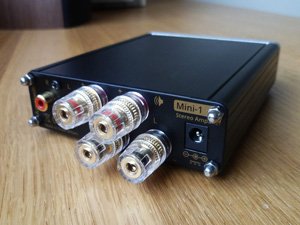 beautifully rounded edges I think it looks seriously cool as well as purposeful. The single pair of RCA input sockets and the speaker cable binding posts (accepting spades, bare wire and banana plugs) grip well and are of good quality. There’s adequate cable room at the back and I was easily able to bi-wire from the terminals, simultaneously using spades and 4mm banana plugs.
beautifully rounded edges I think it looks seriously cool as well as purposeful. The single pair of RCA input sockets and the speaker cable binding posts (accepting spades, bare wire and banana plugs) grip well and are of good quality. There’s adequate cable room at the back and I was easily able to bi-wire from the terminals, simultaneously using spades and 4mm banana plugs.
The volume control can be bypassed, turning the Mini-1 into a power amp, and the quite bright blue power LED turned off, using on-board jumper settings; a fairly simple procedure for the customer requiring a pair of needle-nosed pliers.
Sound Quality
Where the older Mini-T amp really excels is in openness and transparency, image focus and soundstaging, palpability and presence. Which is fine by me as that is where my own audio priorities lie. It’s not just good for a £60 amp, in my honest opinion in many musically important ways it can take on the best amps I have heard at 5 or even 50 times the price or more. Happily, the new Mini-1 amp retains these qualities, while spreading its wings somewhat and providing noticeably more power and headroom in the bass. It’s a more powerful sound with a solid, taut, extended and free-flowing bass foundation.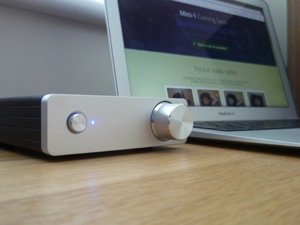
There’s an overall naturalness, a “yeah, that’s how the music should sound” about the Mini-1 that I find pretty much totally satisfying and that I can return to with a smile again and again. It’s musically alive with a sense of tactile palpable presence in a way that is so rare in an audio component.
Well, that all sounds very impressive, doesn’t it. But is it really the Perfect Amplifier?
Well, no. Resolution is good but not top notch. Despite its amazingly open and extended high frequencies, like the Mini-T before it, the Mini-1 doesn’t quite resolve the last layer of detail. For example, the repeated ‘spangy clap’ in Eddy Louiss’s synthesiser on Blues for Klook (on his album Sang Mele) doesn’t quite resolve its double-peaked nature like with some amps. It smooths it over a bit. But it still sounds like a very fast amp; hmm, strange that, it sounds contradictory, but it’s true!
And I would describe the overall tonal balance as a bit ‘brightly lit’. For those who favour a more subdued balance, more of an easy-listening experience or for those who prefer to sit further back in the hall or arena, I guess (reluctantly!) that the Mini-1 may not be for you.
And of course, you have the rated power of 20wpc. Based on measurements I have seen for other TA-2020 chip implementations, I strongly suspect that this is with the wind firmly in the right direction and with a level of distortion that is not consistent with high fidelity reproduction. 10wpc is probably nearer the mark, but that’s just a guess, I’ve not seen any measurements for the Mini-1.
But you would likely be very surprised with what that 10wpc can do! – it certainly drives my 84dB/W 4-way speakers to all but truly insane levels on seriously challenging full-range material like the previously mentioned Blues for Klook. And listening to The Buggles’ Age of Plastic album is a grin-inducing experience – the clarity, power and presence are beautifully captured. But my MBLs, large and full-range though they are, are quite an easy load and maybe the Mini-1 would run out of puff into a more challenging speaker? Although that could depend on whether you want to use it for girl-with-guitar or dubstep, string quartet or full symphony orchestra. It is equally unconstrained on my Usher X719 speakers. 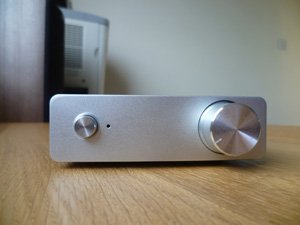
But I have heard of situations where the older Mini-T amp does not weave its magical spell and sounds uncharacteristically earthbound, maybe the Mini-1 will be the same? As ever in audio system component matching, synergy is crucial. There’s only one way to find out if it will work for you – try one!
Summary
I am awestruck by this amp. Not just ‘for the money’, but in absolute terms. It’s a great amplifier, full stop. If I was unable to continue my ‘boxswap’ habit, enjoying the variety provided by a frequently varying audio system, what would my “final amp” be? – in truth, I’d be more than happy if it was the Amptastic Mini-1. I could not say that for the vast majority of the many amps that have passed through my system over the past 30 years or so of my obsession with this hobby. I’m not sure that I can give a recommendation stronger than that.
I can live with one input; and the music sounds real and in-the-room even if I know that a bit more resolution can be had; I enjoy a tonal balance a tad on the bright side; and you’d require an industrial strength crowbar to part me from my MBL speakers and they work well with the Mini-1; so my only real reservation would be the practical one of lack of remote control – but hooked up after my lovely remote-controlled Restek Consens pre-amp the Mini-1 still sounds great! And that solves the issue of lack of multiple inputs as well.
Is this amp too inexpensive for you to take seriously? Maybe – but if so, that’s your loss!
Recommended with the utmost enthusiasm!
Author – Jerry Jacobs
Review systems:
MBL 116F speakers, Restek Consens pre-amp, Jolida FX3 DAC, Pioneer DV-717 (CD transport). Cabling by XLO, MCRU, Atlas, Audioquest.
Usher X-719 speakers, Denon DCD 6.5 midi CD player, Sony 1000ESD pre-amp.
How we carry out reviews.
Read more Hifi Review.























































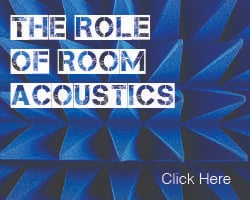












































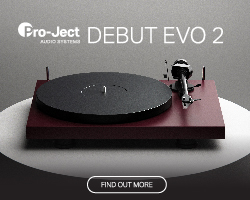







































































































Not aware of this specific model, but I’m using a very similat appearing Topping amp which also uses the TA2020 chip. It’s remarkable. The 2 NAD amps I used before never, ever sounded this good. It’ s just coherent.
The first thing I did when I plugged it in was play a ton of recordings with a lot of vocals. That’s always a good sign.
It really does sound like a low power tube amp but without the mushy bass. I’m not saying it’s the most neutral sound. It leans to the warmer end of the spectrum. But I’m not an ‘audiophile’. I like MUSIC. I just won’t buy albums just because they have great sound. If I don’t like the tunes I don’t care if it’s brilliantly recorded or not.
But this type of sound is a lot more forgiving of bad recordings … ie. most of them. I can listen to a lot of stuff I have now without wincing.
I found a review with edecent measurements of the Usher X719s. Tney’re not that efficient but the impedance from about 2KHz to 20K is around 6 ohms, which seems to make T-amps the happiest.
The speakers I’m using with the Topping are actually an old pair of Paradigm Compact Monitors, which is the precursor to the Series 20’s but before they started using metal tweeters. They’re rated 6 ohms nominal but I don’t have an actual impedance curve. There’s no treble rise you’ll tend to get with T-amps with 8 ohms or more in the high end though.
I listen in the near field and the Topping will play louder than I listen. In a larger room you may want to try it first. Fortunately it wouldn’t be difficult to carry a T-amp to the store.
The Amptastic model is a bit special, Rob – even by the excellent standards of the lovely TA2020 chip!
Having read Jerry’s review on the Amptastic mini-1 amp I decided toi give it a whirl even though i have been more than happy with my current system, happier than i ever have been, but what the hey, its only a hundred quid. I placed my order knowing that production of the said amp was a couple of weeks away and basically forgot about it.
5 days ago my neighbour knocked on my door brandishing a small parcel which he had accepted deliver of, on my behalf. It wasnt until i opened it that i remembered what it was. Very small, brushed silver and very well finished. Straight to my study and not happy with the supplied kettle lead, i upgraded that for a more snug fit. Plugged it in, turned it on and left it overnight to burn in. Next morning turned it off for a while and connected up the speakers,set it to low and left it a few more hours. That evening i sat down with my ipad and heard the low sounds from the next room and thought it may be time to give it a whirl? Too low to listen to, i turned it to 10 o’clock. Shock, shock again. What is going on here, punchy bass and plenty of it, lovely mids and highs that sound so real. No way. Up a few more notches, 11, 12 , 1 o’clock and either it was getting strained or too much for my room. Took it back a little and ….perfect. Change cd, lovely…classical, jazz, female and male vocals, live , wow. Astonishing. Forget what this cost, it is an unbelievable amp. Had two friends around and they can hear the difference. This is some amp. You are a fool if you do not give this a whirl. Great review Jerry and spot on. Staying in my system, you betcha. Could valves be a thing of the past..
Used with Consonance Droplet Cdp, Mowgan Audio Mabon speakers. 6 or 7k of equipment with £100 amp. yup. I have no shame. Its all about the sound.